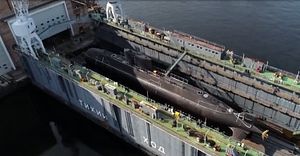Russia second Project 677 Lada-class diesel-electric attack submarine (SSK), christened Kronstadt, will undergo a series of trials in 2019, the commander in chief of the Russian Navy, Admiral Vladimir Korolyov, told reporters during a visit to the Rubin Central Design Bureau for Marine Engineering in St. Petersburg this month.
“Serial production of the non-nuclear Lada-class submarines continues. This year, testing will commence on the second non-nuclear Lada-class submarine Kronstadt, which was launched in September 2018,” Korolyov was quoted as saying by TASS news agency on February 22. The Kronstadt, was officially launched at the St. Petersburg-based Admiralty Shipyards on September 20 thirteen years after the SSK was laid down.The construction of the Kronstadt was was suspended in 2011 due to a number of design and technical challenges, in addition to a funding shortage, and only restarted in 2013.
“The submarine began to be built in 2005,”Admiralty Shipyard CEO Alexander Buzakov said during the launching ceremony in September 2018. “There have been some pauses in construction work and in financing, but the launch day has come at last. The delay in construction work allowed for using the experience gained in building and operating the submarine The St. Petersburg. By all parameters this submarine surpasses its predecessor – Project 636 [improved Kilo-class]. We are certain that the future of non-nuclear submarine force of the Russian Navy should be pinned on project 677. There will be a large series.”
The Russian Ministry of Defense (MoD) planned for a fleet of six Lada-class SSKs. To date, only one submarine, the St. Petersburg, laid down in 1997, has entered service with the Russian Navy. Funding for one more Lada-class attack, the Velikiye Luki, has been secured under Russia’s current armament plan. Contracts for the fourth and fifth Lada-class SSK are expected to be signed this year, however, given current funding priorities, construction will likely cease after the handover of the Velikiye Luki.
In its place, the Russian Navy procure additional Project 636.3 Kilo-class (aka Vashavyanka-class) diesel-electric attack submarines, which are an improved variant of the original Project 877 Kilo-class design. Lada-class boats are smaller and cheaper than the most advanced Kilo-class variant, but still yield substantial fire power: Lada-class SSKs are armed with both torpedoes and cruise missiles from its six 533-millimeter torpedo tubes including M-54 Kalibr (NATO designation: SS-N-27A “Sizzler”) cruise missiles. As I reported last year:
Lada-class subs purportedly have a very low acoustic signature due a special anti-sonar coating called Molniya (Lightning), which led a number of defense analysts calling the boats the ‘Mini-Red October class.’
With a total displacement of 2,700 metric tons (submerged), the sub only needs a crew of 38 to operate. Lada-subs are equipped with an advanced sonar and the automated combat control system Litiy. The submarine can accommodate six torpedo tubes and [reportedly] features specialized vertical missile silos for anti-ship and land attack cruise missiles. The Lada-class’ primary mission will be coastal defense against enemy submarines and surface vessels, surveillance and reconnaissance as well as intelligence gathering missions.
It is noteworthy that that there are no plans to fit the Lada-class SSKs with air-independent propulsion systems (AIP) for the time being.
































